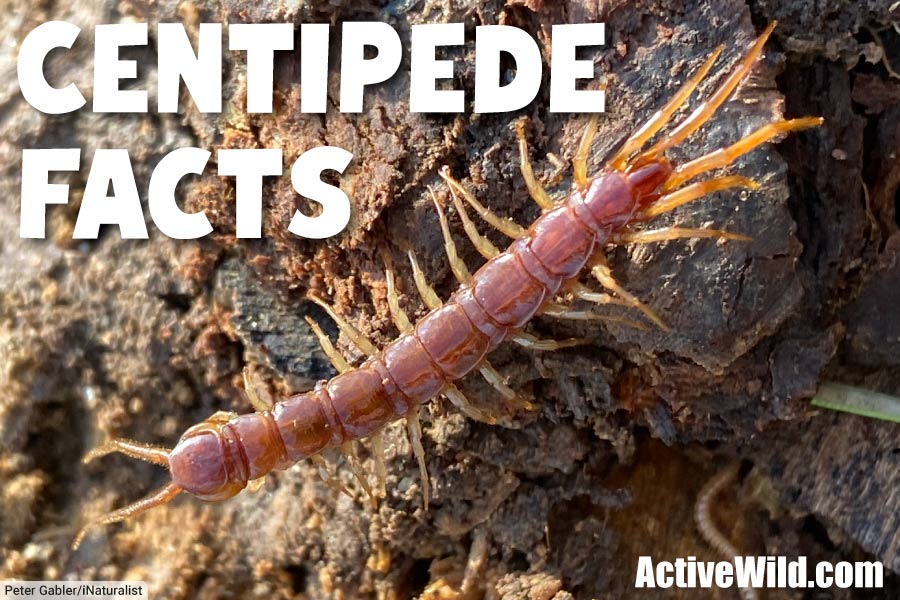Centipede facts, pictures and information. Find out exactly what a centipede is, what centipedes eat, where they’re found, and much more…
Page Index
Related Pages on Active Wild
What Is a Centipede?
A centipede is an invertebrate predator in the class Chilopoda. A centipede has a long, segmented body with one pair of legs per segment (unlike a millipede, which has two pairs of legs per segment).
The name “centipede” comes from the Latin centi (hundred) + pedis (foot), but the actual number of feet varies: the common house centipede Scutigera coleoptrata has 30 legs, whereas the southern European centipede Himantarium gabrielis can have more than 350.
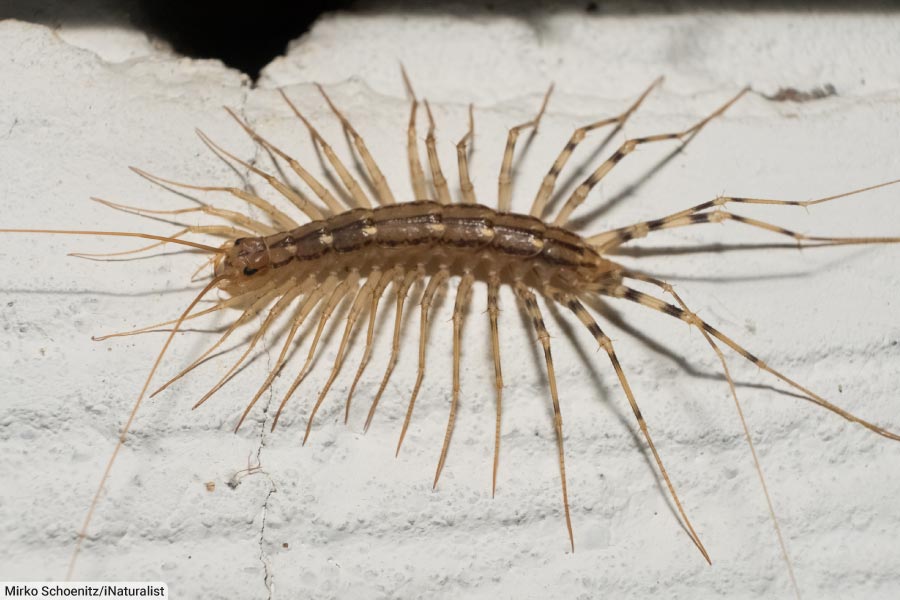
Centipedes always have an odd number of pairs of legs, meaning that no centipede actually has exactly 100 legs!
Centipedes are metameric, meaning their bodies are organized in clearly defined segments. The head and tail segments are highly specialized, but the middle segments are all very similar, each one bearing a single pair of legs.
Each pair of legs is longer than the pair in front. This ensures the centipede doesn’t trip over its own legs!
How Many Centipede Species Are There?
There are an estimated 6,950 species of centipede scattered all over the world, from the Arctic to the Amazon (some estimates put the total number of centipede species at 8,000).
Less than half of those species have been discovered and named so far; the Catalogue of Life identifies 3,145 known species of centipede. (Source, 25th Sept 2023)
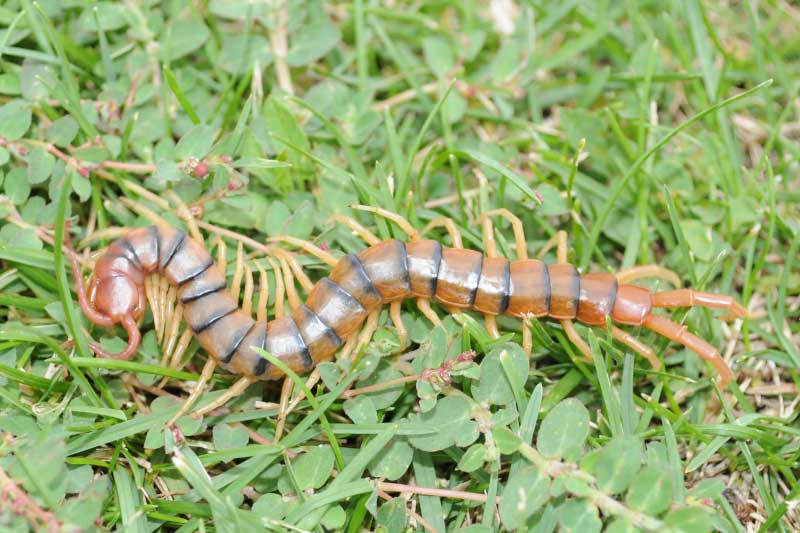
Is A Centipede An Insect?
Although they look like insects, centipedes and insects are only distant relatives. Both centipedes and insects (along with arachnids, crustaceans, and the ancient horseshoe crabs) belong to the phylum Arthropoda.
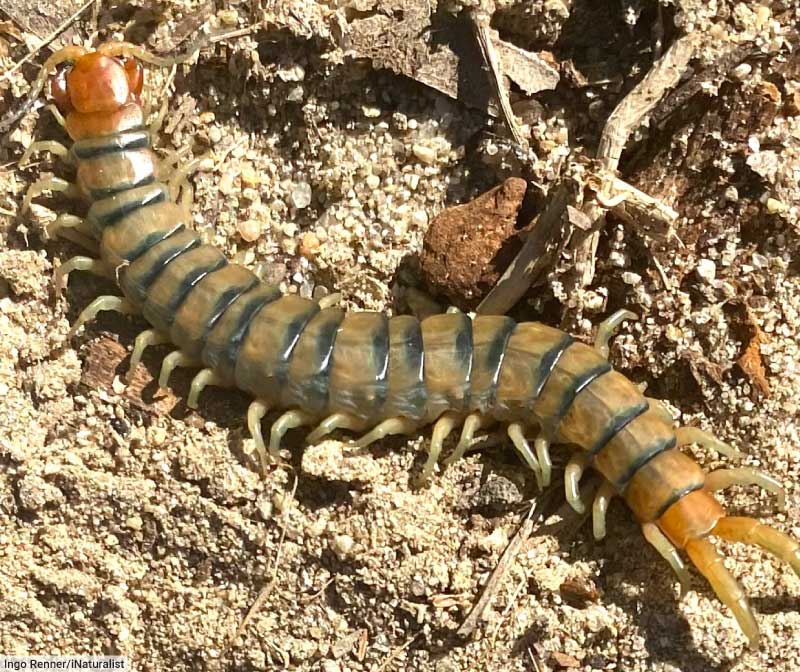
The arthropods are among the oldest complex animals, having evolved around 500 million years ago – after all that time, it’s no surprise they’ve evolved so much diversity.
An irrational fear of centipedes is called chilopodophobia (the name comes from Chilopoda, the scientific name for centipedes).
Some species of centipede are remarkably attentive parents. Females will guard the eggs from predators and clean them to prevent infection. In a few species, this protective behavior extends even after the eggs hatch.
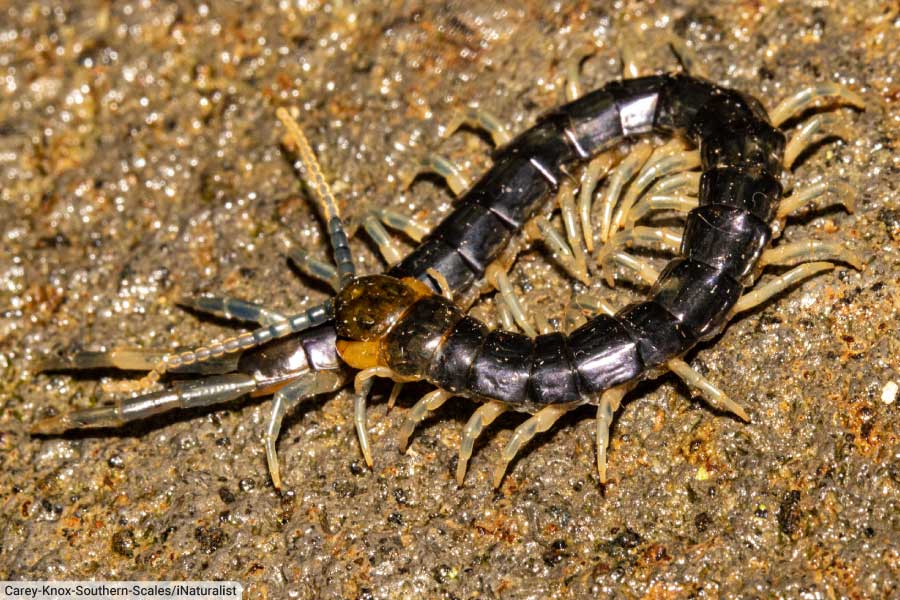
Are Centipedes Poisonous?
Centipedes are venomous, but generally not enough to harm humans. Still, a centipede bite can be painful, especially from one of the larger species. Like most stings, the biggest risks come not from the bite itself but from the allergic reaction some people experience afterwards.
The centipede’s venom glands are located in the pincer-like claws (known as forciples) that project from its head section.
Centipedes Glow In Ultraviolet Light
Bizarrely, centipedes glow under blacklight (Ultraviolet A). If you go out at night with a common UV-A flashlight, you’ll see centipedes (as well as millipedes and scorpions) stand out like pale green lightbulbs.
No one is really sure why – we know something about the chemical compounds that cause the glow, but the evolutionary function (if there is one) is still a mystery.
World’s Largest Centipede
The largest centipede in the world is the Amazonian giant centipede (Scolopendra gigantea). The species, which is found in tropical forests of northern South America, especially Colombia and Venezuela, routinely reaches 10” in length. Although the Guinness Book of World Records states that 10” is the record for longest centipede, scientists have reported even longer specimens – more than 12” in some cases.
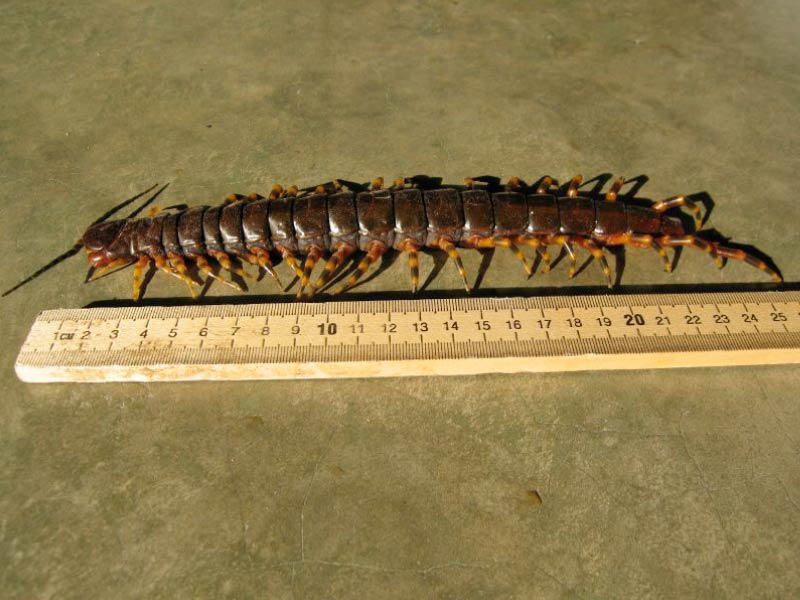
Most centipedes eat small invertebrates, but the Amazonian giant centipede is big enough to hunt mice, frogs, birds, and other relatively large prey. In one cave in Venezuela, scientists discovered a population of giant centipedes that hang down from the ceiling, snatching bats out of the air and killing them with venom.
World’s Smallest Centipede
The biggest centipedes are found in tropical rainforests, but the smallest may be right near your front door. In 2002, scientists discovered a new species of centipede living in New York’s Central Park. The species is named Hoffman’s dwarf centipede Nannarrup hoffmani.
At less than half an inch long, it was the smallest centipede ever discovered. Its discoverers think it may not be native to New York, though, and may instead have arrived from Asia on ships or airplanes.
Centipede With The Most Legs
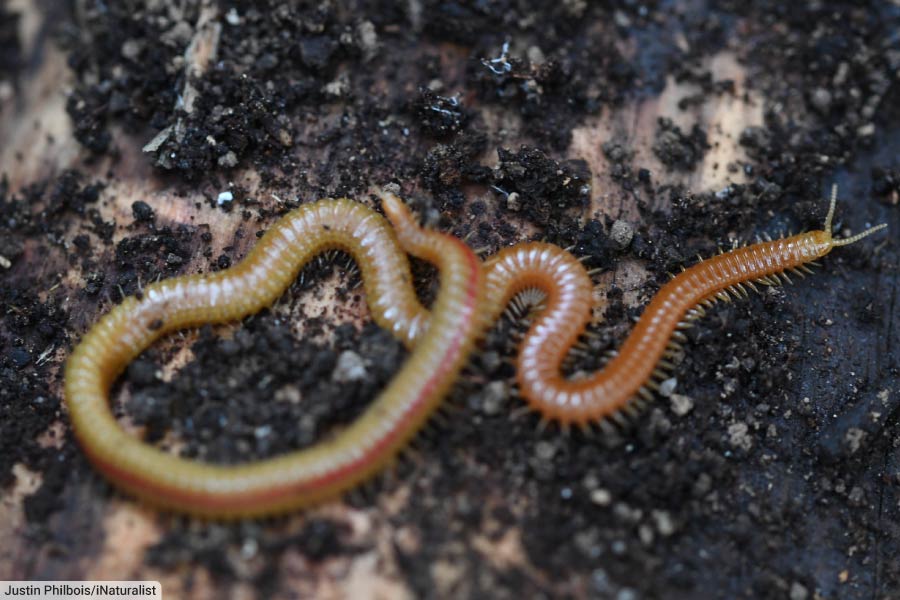
The centipede thought to have the most legs is Himantarium gabrielis, a species found in Southern Europe from Portugal to Greece. Although much smaller than its Amazonian cousins (only 5-8 inches in length), H. gabrielis has far more body segments: up to 179 in the largest males. At 2 legs per segment, that comes out at 354 legs.
Prehistoric Centipedes
Fossil centipedes date back to 430 million years ago, making them one of the oldest still-living animal forms. Centipedes were among the first animals to crawl out of the ocean and make a living on land (millipedes and scorpions actually got there first, but centipedes were close behind).
One hypothesis suggests that the first land-living animals were scavengers who would patrol the shore for washed-up corpses. Because nothing else could live on the land, there was no competition for those resources – and no predators to be wary of, until the arrival of animals such as early centipedes.
Can Centipedes Swim?
The ancient ancestors of centipedes were aquatic or amphibious beach-combers, but today’s centipedes are all restricted to the land… or, at least that’s what we used to think.
In 2001, scientists discovered Scolopendra cataracta, a Southeast Asian cousin of the Amazonian giant centipede.
S. cataracta, it turns out, is a powerful swimmer that can find prey on land or in water. After hundreds of millions of years, this one species seems to have re-evolved the aquatic lifestyle of its distant ancestors!
Centipedes vs Millipedes
Both centipedes and millipedes belong to the subphylum Myriapoda. Although they look somewhat similar, with practice the difference between centipede and millipede is easy to spot.
Whereas centipedes only have two legs (i.e., one pair of legs) per segment, millipedes have four (i.e., two pairs of legs). That gives millipedes a much more “leggy” appearance.
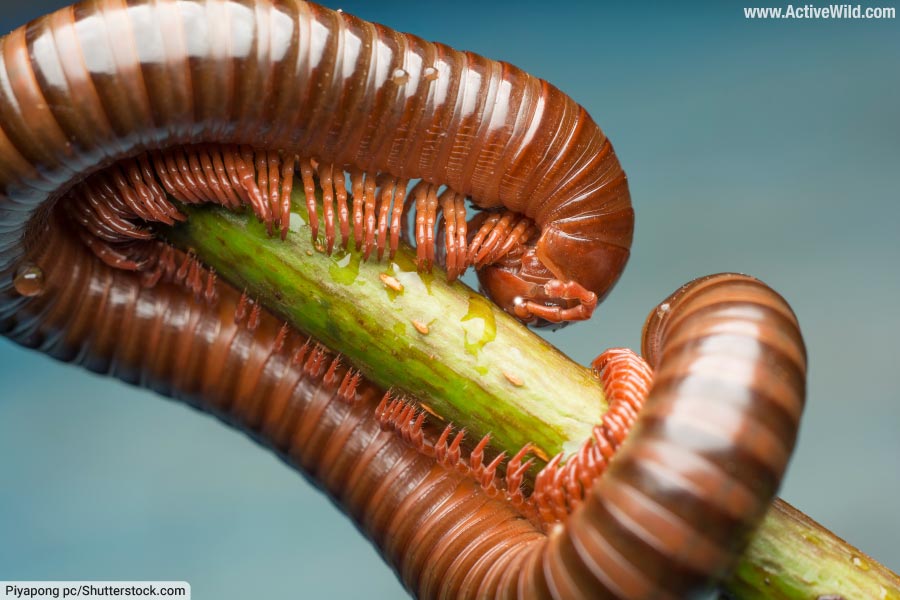
The legs of a centipede are splayed out to the sides rather than positioned directly under the body, as is the case in millipedes.
Centipedes have a flat profile, whereas millipedes look more rounded or tubular.
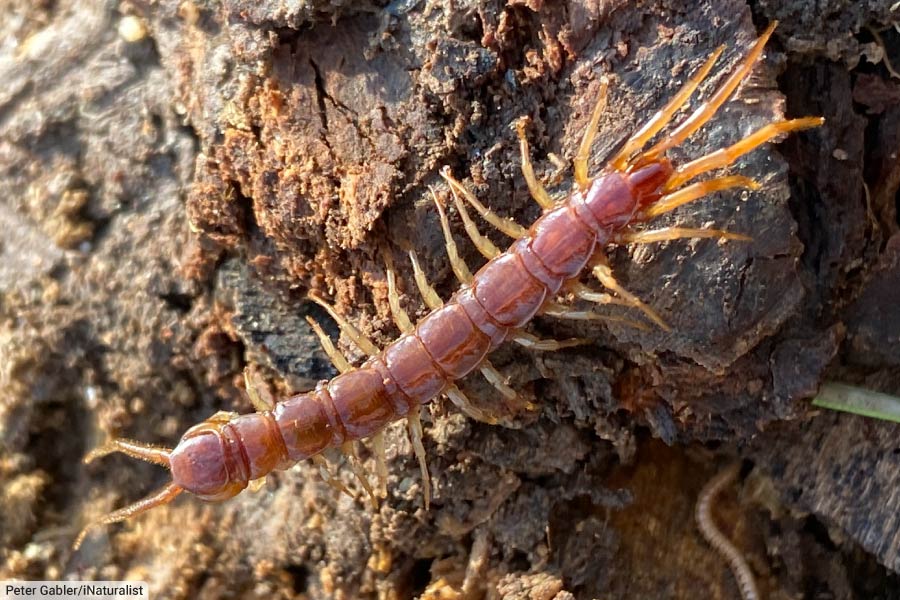
If it curls into a ball when threatened, it’s a millipede. Centipedes prefer to bite and then run away.
Centipedes and millipedes have very different lifestyles. Centipedes are active predators, but millipedes are generally detritivores, meaning they feed on decaying organic matter.
Centipedes and millipedes both have enormous variation in size, millipedes slightly more so. The smallest millipedes are only a tenth of an inch in size, whereas the largest are as much as 15 inches.
So millipedes show greater extremes at both ends of the size spectrum. In the past, millipedes were even more impressive: Arthropleura, which lived in North America some 300 million years ago, was 8 feet long and a foot and a half wide.
What Do Centipedes Eat?
All centipedes are predators. They seem to have no particular preference when it comes to prey and are happy to go after whatever is small enough to fit in their mouths. For the most part, that means small insects and other invertebrates, but the largest centipedes can take vertebrate prey as well.
As active hunters, some centipedes have evolved to be incredibly fast. The common house centipede is reckoned to be the fastest of all arthropods, with a maximum speed of more than a foot per second. (That’s less than 1mph, but still plenty fast for something so small.)
One secret to the centipede’s speed is the arrangement of its legs: the legs get longer as you move back on the centipede’s body, which keeps the centipede from tripping over itself.
Are Centipedes Dangerous?
Most centipedes use venom to kill their prey. Because centipede bites are not particularly serious and not particularly common, there has been less research into their venom than into the venom of snakes or bees, which are considered more medically relevant.
We do know that centipede venom is a neurotoxin, like scorpion venom but unlike bee venom. And a 2018 paper suggests that the larger centipedes have a unique, fast-acting compound in their venom that helps them immobilize large and potentially dangerous prey such as rodents.
House centipedes are a common sight in American homes, though often an unwelcome one. They’re ugly, with wide-splayed legs and long antennae, and their rapid movements freak people out. But they’re harmless, and in fact may be beneficial: by hunting cockroaches, moths, termites, and other pests, they can actually prevent damage to houses. They’re like tiny, creepy little exterminators.
However, even though the centipedes themselves are harmless, a large population of house centipedes can be an indication of underlying problems. Just as the presence of lions indicates a healthy population of large herbivores, having house centipedes probably means there are lots of other bugs around for them to feed on.
Further Reading And References
‘Horrific’ First Amphibious Centipede Discovered (nationalgeographic.com)
Luminous Beauty: The Secret World of Fluorescent Arthropods | WIRED
Centipede or Millipede? What’s the Difference? – Carnegie Museum of Natural History (carnegiemnh.org)
House Centipede | Office for Environmental Programs Outreach Services (uky.edu)
Deadly component of centipede venom identified | Research | Chemistry World
Adis, J., & Harvey, M. S. (2000). How many Arachnida and Myriapoda are there world-wide and in Amazonia? Studies on Neotropical Fauna and Environment, 35(2), 139–141. https://doi.org/10.1076/0165-0521(200008)35:2;1-9;FT139
Lewis, J. G. E. (2006). The Biology of Centipedes. Cambridge University Press.
Molinari, J., Gutiérrez, E., De Ascencao, A., Sar, M., Arends, A., & Már-Quez, R. (2005). Predation by giant centipedes, Scolopendra gigantea, on three species of bats in a Venezuelan cave. Caribbean Journal of Science, 41, 340–346.
Shelley, R., & Kiser, S. (2000). Neotype designation and a diagnostic account for the centipede, Scolopendra gigantea L. 1758, with an account of S. galapagoensis Bollman 1889 (Chilopoda Scolopendromorpha Scolopendridae). Tropical Zoology – TROP ZOOL, 13, 159–170. https://doi.org/10.1080/03946975.2000.10531129
Stewart, B. (2002, July 24). A New Kind of New Yorker, One With 82 Legs (Published 2002). The New York Times. https://www.nytimes.com/2002/07/24/nyregion/a-new-kind-of-new-yorker-one-with-82-legs.html

